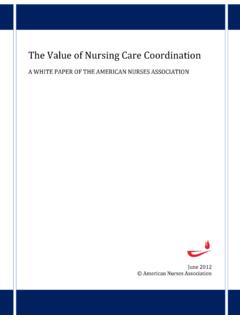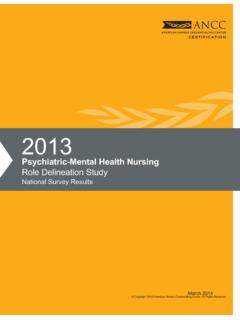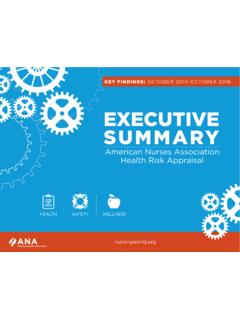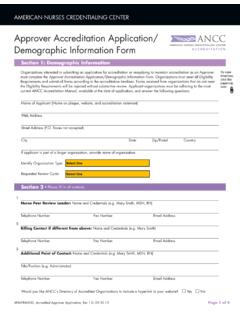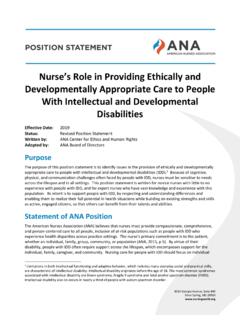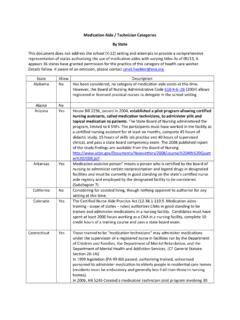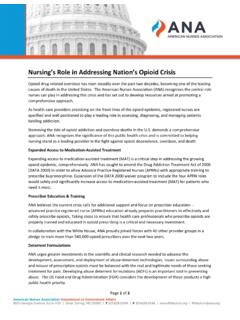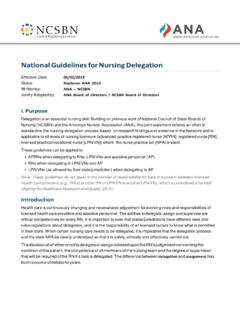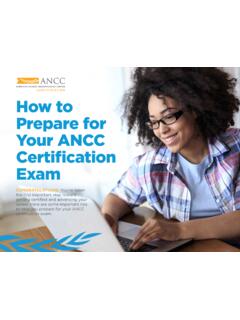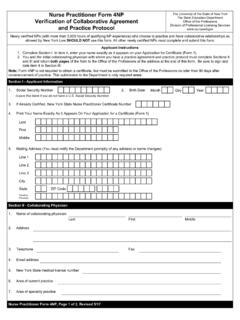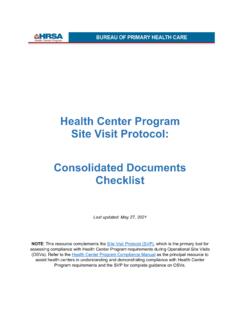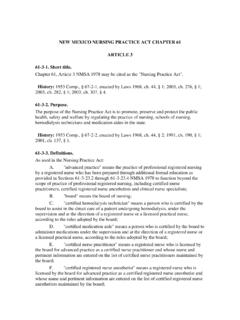Transcription of ANA Principles for Advanced Practice Registered Nurse ...
1 ANA's Principles for Advanced Practice Registered Nurse (APRN). Full Practice Authority Purpose The American Nurses Association's (ANA's) Principles for APRN Full Practice Authority provide policymakers, Advanced Practice Registered nurses (APRNs), and stakeholders with evidence-based guidance when considering changes in statute or regulation for APRNs. Background With the implementation of the Patient Protection and Affordable Care Act of 2010 (ACA), now more than ever there is a growing sense of urgency for states to increase the number of health care providers, particularly primary care providers. Supported by a growing body of evidence on the safe and cost- effective provision of care by APRNs, there is a national call to remove all barriers to full Practice authority from organizations such as the Institute of Medicine (IOM), the National Governors Association (NGA), the Federal Trade Commission (FTC), the Bipartisan Policy Center, and the Veteran's Health Administration, among others.
2 ANA strongly supports full Practice authority for all APRN roles. Full Practice authority is generally defined as an APRN's ability to utilize knowledge, skills, and judgment to Practice to the full extent of his or her education and training. The American Association of Nurse Practitioners has offered a definition of full Practice authority as the collection of state Practice and licensure laws that allow for Nurse practitioners to evaluate patients, diagnose, order and interpret diagnostic tests, initiate and manage treatments including prescribe medications under the exclusive licensure authority of the state board of nursing (Issues At-A-Glance: Full Practice Authority, 2014). Twenty-one states and the District of Columbia currently grant full Practice authority to one or more APRN roles upon licensure and/or certification.
3 Several of these states have passed full Practice authority legislation or made similar regulatory changes since passage of the ACA in 2010. The National Council of State Boards of Nursing (NCSBN) maintains the APRN map project, which provides an overview of each state's implementation of the Consensus Model for APRN Regulation, including independent Practice (defined as no requirement for a written collaborative agreement , no supervision, no conditions for Practice ). While many are working to obtain full Practice authority for APRNs through legislative and regulatory efforts, analysis has revealed a disturbing trend in state legislation requiring a supervised post-licensure Practice or transition period, often referred to as transition to Practice requirements, further delaying APRN full Practice authority.
4 In several states (see table below), legislation has been enacted with the intention of moving closer to full Practice authority for one or more APRN roles, yet the legislation includes new requirements for a supervised Practice period following licensure and/or certification. These legislative restrictions are modeled in concept after the state of Maine's 1995/2007 legislation, a supervised Practice provision of 24 months. Discussion with stakeholders reveals that these changes have not been based on evidence but are the result of political compromise. As demonstrated in the table, states have unique time periods and standards for this transition to Practice , none of which are supported by the evidence or research.
5 As states begin to implement these requirements, there is a growing realization of the potential impact on the workforce and access to care. In a report published in November 2014, the Nurse Physician Advisory Taskforce for Colorado Healthcare (NPATCH) described how it evaluated perceived barriers created by the legislation passed in that state: employers are reticent to hire new graduates because they are unable to prescribe independently, supervision requirements create an unnecessary burden for preceptors and mentors, and APRNs are often unable to be empaneled and bill for services independently. The Taskforce generally found the barriers to be real and made recommendations to streamline the process for APRNs to obtain prescriptive authority, including reducing the transition requirement to six months' full-time or 1,000 Practice hours.
6 States with Transition to Practice Barriers Year Transition APRN Role State Legislation Oversight Requirement/Comments Requirement Affected Passed Maine 1995/2007 24 Months CNP Physician or CNP. Colorado 2009 3,600 Hours CNP, CNS, Required when seeking independent CNM, CRNA prescriptive authority; physician or physician and APRN. 2015 1,000 Hours CNP, CNS, Hours reduced for prescribing CNM, CRNA mentorship with a physician or APRN. required when seeking autonomous prescriptive authority Vermont 2011 24 Months and CNP, CNS, collaborative agreement with an APRN. 2,400 Hours CNM, CRNA or physician Nevada 2013 2 Years or CNP, CNS, Required when seeking independent CS. 2,000 Hours CNM II prescriptive authority; collaborating physician-approved protocols for CS II.
7 Prescribing Minnesota 2014 2,080 Hours CNP, CNS collaborative agreement with an APRN. or physician Connecticut 2014 3 Years and CNP, CNS collaborative agreement with a 2,000-Hours physician Minimum New York 2014 3,600 Hours CNP collaborative agreement with a physician; attestation of collaboration requirement Nebraska 2015 2,000 Hours CNP Transition-to- Practice agreement with a supervising provider (MD, DO, or NP). Year Transition APRN Role Oversight Requirement/. State Legislation Requirement Affected Comments Passed Maryland 2015 18 Months CNP An applicant who has never been certified by Maryland or another state shall consult and collaborate with a physician or CNP mentor (who has at least 3 years' experience ).
8 Delaware 2015 2 Years and CNP, CNS, collaborative agreement with a hospital 4,000 Full-time CNM, CRNA or integrated clinical setting Hours ( Independent Practice ). Minimum West Virginia 2016 2 Years CNP, CNS, collaborative Relationship and CNM, CRNA agreement with a qualified collaborating health care professional (physician or APRN) when seeking full autonomous prescriptive authority Virginia 2018 5 years FTE CNP File an attestation from the based on a 36 collaborating physician with the hour work week, 1,800 Board of Nursing hours per year for a total of 9,000 hours National APRN organizations have provided information and guidance for their memberships on this issue through position statements and briefs, which are referenced in this document.
9 Continued and increasing variability in state Practice requirements for APRN full Practice authority does not bring the nation toward consensus, but institutes additional layers of unnecessary regulatory constraint and costs. ANA and our constituent and state nurses associations (C/SNAs) are committed to working with other national nursing organizations and key stakeholders to remove barriers to APRN Practice in order to ensure patients have access to safe and effective care from the providers of their choice. Essential Principles 1. Consensus across four APRN roles ANA endorsed the Consensus Model for APRN Regulation and fully supports the definition of APRNs as licensed independent practitioners who are expected to Practice within standards established or recognized by a licensing body.
10 ANA endorses the Nurse Practitioner Roundtable's white paper, Nurse Practitioner Perspective on Education and Post- Graduate Training, and believes the Principles espoused in that document apply to all APRN roles. a. Research conducted by the Council on Accreditation of Nurse Anesthesia Educational Programs (COA), (Cook, 2013) reports recent graduates of accredited certified Registered Nurse anesthetist (CRNA) programs are prepared and perform competencies for entry into Practice upon certification and licensure. b. In the Joint Statement of Practice Relations between Obstetrician-Gynecologists and Certified Nurse -Midwives/Certified Midwives, the American College of Nurse -Midwives and the American College of Obstetricians and Gynecologists affirm that graduates of accredited certified Nurse - midwife (CNM)/certified midwife (CM) educational programs who hold professional certification are licensed independent c.
